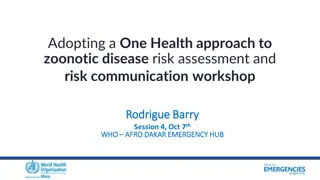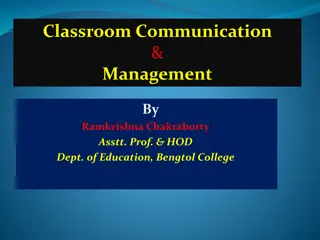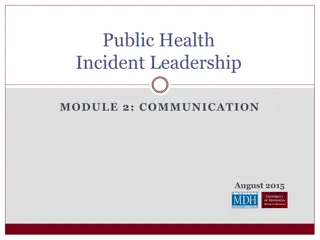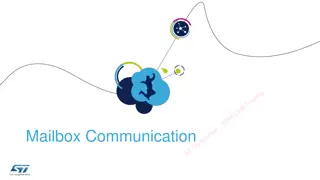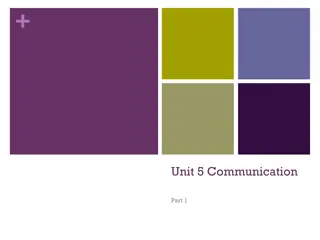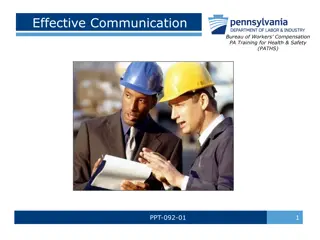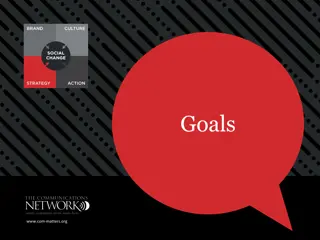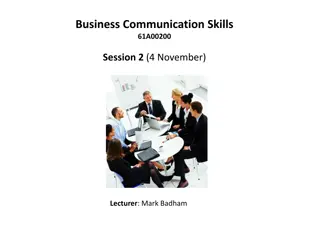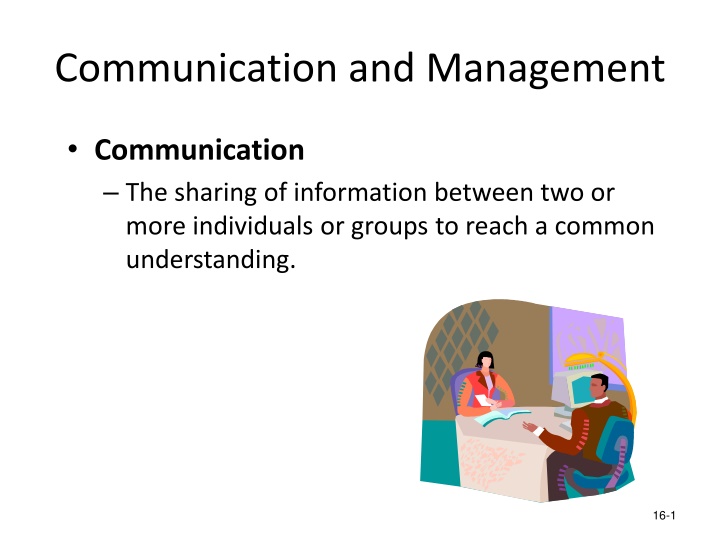
Enhancing Communication Skills in Management
Explore the importance of good communication in management, the phases of the communication process, and the roles of sender, receiver, encoding, decoding, and feedback. Understand how effective communication can lead to improved efficiency, product quality, customer responsiveness, and innovation.
Download Presentation

Please find below an Image/Link to download the presentation.
The content on the website is provided AS IS for your information and personal use only. It may not be sold, licensed, or shared on other websites without obtaining consent from the author. If you encounter any issues during the download, it is possible that the publisher has removed the file from their server.
You are allowed to download the files provided on this website for personal or commercial use, subject to the condition that they are used lawfully. All files are the property of their respective owners.
The content on the website is provided AS IS for your information and personal use only. It may not be sold, licensed, or shared on other websites without obtaining consent from the author.
E N D
Presentation Transcript
Communication and Management Communication The sharing of information between two or more individuals or groups to reach a common understanding. 16-1
Communication and Management Importance of Good Communication Increased efficiency in new technologies and skills Improved quality of products and services Increased responsiveness to customers More innovation through communication 16-2
The Communication Process Phases of the Communication Process: Transmission phase in which information is shared by two or more people. Feedback phase in which a common understanding is assured. 16-3
The Communication Process Figure 16.1 16-4
Question? What part of the communication process has the sender translating the message into symbols or language? A. Message B. Encoding C. Decoding D. Feedback 16-5
The Communication Process Sender person wishing to share information with some other person Message what information to communicate Encoding sender translates the message into symbols or language Noise refers to anything that hampers any stage of the communication process 16-6
The Communication Process Receiver person or group for which the message is intended Medium pathway through which an encoded message is transmitted to a receiver Decoding - critical point where the receiver interprets and tries to make sense of the message 16-7
The Communication Process Feedback phase is initiated by the receiver Receiver decides what message to send to the original sender Feedback eliminates misunderstandings, ensures that messages are correctly interpreted 16-8
Verbal & Nonverbal Communication Verbal Communication The encoding of messages into words, either written or spoken Nonverbal The encoding of messages by means of facial expressions, body language, and styles of dress. 16-9
The Role of Perception in Communication Perception process through which people select, organize, and interpret sensory input to give meaning and order to the world around them 16-10
The Role of Perception in Communication Biases systematic tendencies to use information about others in ways that can result in inaccurate perceptions 16-11
The Role of Perception in Communication Stereotypes often inaccurate beliefs about the characteristics of particular groups of people can interfere with the encoding and decoding of messages 16-12
The Dangers of Ineffective Communication When managers and other members of an organization are ineffective communicators, organizational performance suffers and any competitive advantage the organization might have is likely to be lost 16-13
Information Richness and Communication Media Managers and their subordinates can become effective communicators by: Selecting an appropriate medium for each message there is no one best medium. Considering information richness A medium with high richness can carry much more information to aid understanding. 16-14
Information Richness The amount of information that a communication medium can carry The extent to which the medium enables the sender and receiver to reach a common understanding 16-15
Information Richness of Communication Media Figure 16.2 16-16
Communication Media Face-to-Face Has highest information richness. Can take advantage of verbal and nonverbal signals. 16-17
Communication Media Face-to-Face Provides for instant feedback. Management by wandering around takes advantage of this with informal talks to workers. Video conferences provide much of this richness and reduce travel costs and meeting times. 16-18
Communication Media Spoken Communication Electronically Transmitted Has the second highest information richness. Telephone conversations are information rich with tone of voice, sender s emphasis, and quick feedback, but provide no visual nonverbal cues. 16-19
Communication Media Personally Addressed Written Communication Has a lower richness than the verbal forms of communication, but still is directed at a given person. Personal addressing helps ensure receiver actually reads the message personal letters and e-mail are common forms. 16-20
Communication Media Personally Addressed Written Communication Does not provide instant feedback to the sender although sender may get feedback later. Excellent media for complex messages requesting follow-up actions by receiver. 16-21
E-Mail Dos and Donts E-mail allows telecommuting employees to work from home and keep in contact. The use of e-mail is growing rapidly and e-mail etiquette is expected: Typing messages in all CAPITALS is seen as screaming at the receiver. Punctuate your messages for easy reading and don t ramble on. Pay attention to spelling and treat the message like a written letter. 16-22
Communication Media Impersonal Written Communication Has the lowest information richness. Good for messages to many receivers where little or feedback is expected (e.g., newsletters, reports) 16-23
Communication Media Many managers do not have time to read all the electronic work-related information available to them Problem with information overload is the potential for important information to be ignored or overlooked Can result in lost productivity 16-24
Communication Networks Communication Networks The pathways along which information flows in groups and teams and throughout the organization. 16-25
Communication Networks Type of communication network depends on: The nature of the group s tasks The extent to which group members need to communicate with each other to achieve group goals. 16-26
Communication Networks in Groups and Teams Type of Network Wheel Network Information flows to and from one central member. Chain Network Members communicate only with the people next to them in the sequence. Wheel and chain networks provide little interaction. Circle Network Members communicate with others close to them in terms of expertise, experience, and location. All-Channel Network Networks found in teams with high levels of communications between each member and all others. 16-27
Communication Networks in Groups and Teams Figure 16.3 16-28
Organization Communication Networks Organization Chart Summarizes the formal reporting channels in an organization. Communication in an organization flows through formal and informal pathways Vertical communications flow up and down the corporate hierarchy. 16-29
Organization Communication Networks Organization Chart Horizontal communications flow between employees of the same level. Informal communications can span levels and departments the grapevine is an informal network carrying unofficial information throughout the firm. 16-30
Formal and Informal Communication Networks in an Organization Figure 16.4 16-31
Technological Advances in Communication Internet Global system of computer networks that is easy to join and is used by employees to communicate inside and outside their companies World Wide Web (WWW) Business district with multimedia capabilities 16-32
Technological Advances in Communication Intranets A company-wide system of computer networks for information sharing by employees inside the firm. Advantages of intranets Lies in their versatility as a communication medium Can be used for a number of different purposes by people who may have little expertise in computer software and programming 16-33
Barriers to Effective Communication Messages that are unclear, incomplete, difficult to understand Messages sent over an inappropriate medium Messages with no provision for feedback Messages that are received but ignored Messages that are misunderstood Messages delivered through automated systems that lack the human element 16-34
Communication Skills for Managers as Senders Send clear and complete messages. Encode messages in symbols the receiver understands. Select a medium appropriate for the message and, importantly, one that is monitored by the receiver. Avoid filtering (holding back information) and distortion as the message passes through other workers. Include a feedback mechanism in the message. Provide accurate information to avoid rumors. 16-35
Communication Skills for Managers as Senders Jargon specialized language that members of an occupation, group, or organization develop to facilitate communication among themselves should never be used when communicating with people outside the occupation, group, or organization 16-36
Discussion Question? What is the most important communication skill for managers? A. Be a good listener: don t interrupt B. Be empathetic C. Ask questions to clarify your understanding D. Understand linguistic styles 16-37
Communication Skills For Managers as Receivers Pay attention to what is sent as a message. Be a good listener: don t interrupt. Ask questions to clarify your understanding. Be empathetic: try to understand what the sender feels. Understand linguistic styles: different people speak differently. Speed, tone, pausing all impact communication. 16-38





